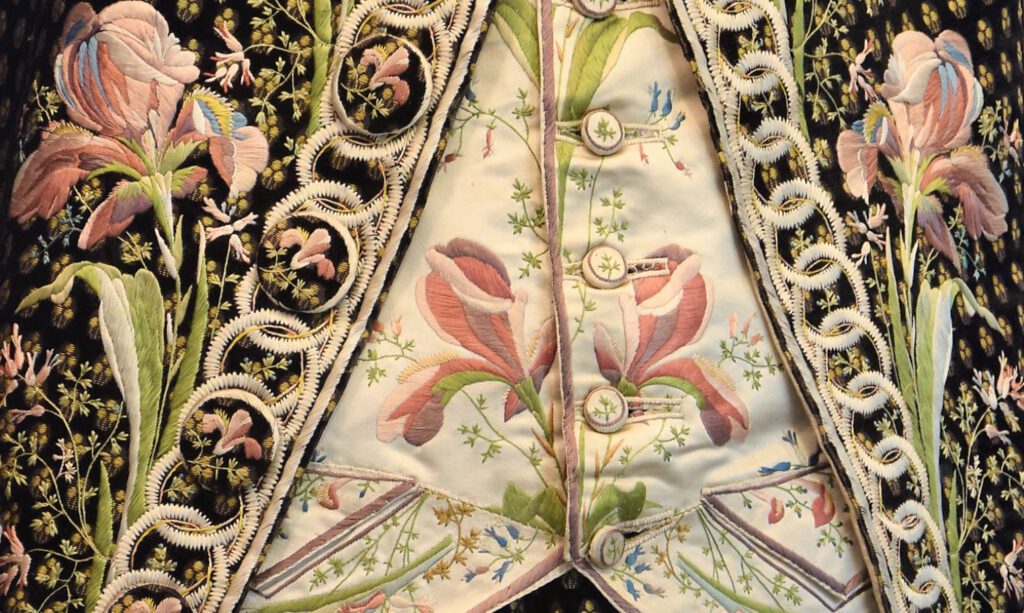
This beautiful gala dress-suit was made in the seconded half of the 18th century. Enjoy some pictures of a truly splendid garment and read more about its owner: an Italian aristocrat with liberal ideas and close links to Napoleon.
Continue reading
This beautiful gala dress-suit was made in the seconded half of the 18th century. Enjoy some pictures of a truly splendid garment and read more about its owner: an Italian aristocrat with liberal ideas and close links to Napoleon.
Continue reading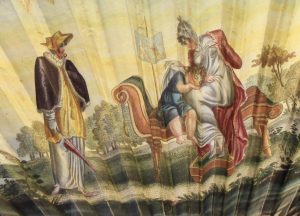
Hand-held fans, previously reserved for royalty and aristocrats, become a must-have accessory for every lady in high society at the end of the 17th century. The trend to carry a fan spreads rapidly through society. With this, the decoration of the fan leave becomes light-hearted: The religious and classical motifs give way to pastoral scenes, al fresco parties, and themes of love-and-courtship. Interestingly, fashion itself also features on the fashionable accessories, serving as a fashion plate and fashion statement.
Continue reading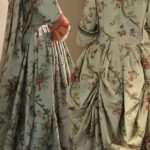 In the years 1750–1775, a fashionable lady would have been dressed in a low-necked gown worn over a petticoat.
In the years 1750–1775, a fashionable lady would have been dressed in a low-necked gown worn over a petticoat.
These gowns were called robes – after the French word for dress, as France was the center of fashion in these days. Continue reading
In this post:
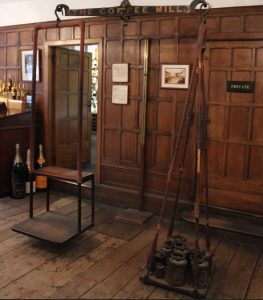 A softly rounded, plumb, curvaceous and voluptuous body was considered healthy and beautiful for most of the 18th century. Nevertheless, with the rise of the ideals of ancient Greek in fashion and design, the athletic body of an Olympian shifted into focus. Fashionable skin-tight pantaloons revealed every muscle of the male leg, the perfectly-cut coat looked best on broad shoulders. To create a specific volume, men wore padded under-structures round the shoulders and calves, and a corset helped to accentuate a man’s waist.
A softly rounded, plumb, curvaceous and voluptuous body was considered healthy and beautiful for most of the 18th century. Nevertheless, with the rise of the ideals of ancient Greek in fashion and design, the athletic body of an Olympian shifted into focus. Fashionable skin-tight pantaloons revealed every muscle of the male leg, the perfectly-cut coat looked best on broad shoulders. To create a specific volume, men wore padded under-structures round the shoulders and calves, and a corset helped to accentuate a man’s waist.
The well-proportioned male body became an object of fashion and health. But how to measure the body weight? Bathroom scales were not yet around, not even for the rich. People had to pay to be weighed at the doctors. Thus, it came in handy for High Society men of London that a wine shop started offering the service to its customers for free in 1765. Actually, weighing became extremely fashionable. Continue reading
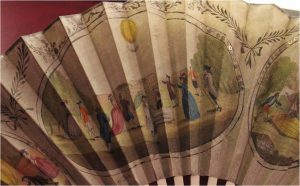 Hand-held fans of the 18th century were more than an accessory. They often commemorated political milestones, were a display of loyalty and patriotism, and celebrated popular social and scientific events.
Hand-held fans of the 18th century were more than an accessory. They often commemorated political milestones, were a display of loyalty and patriotism, and celebrated popular social and scientific events.
For this post, I have compiled 8 fans related to historic events of the 18th century for you. Enjoy the beauty and singularity of the objects, and marvel at the craftsmanship.
 Female fashion of the 18th century featured a fabulous wealth of accessories. This post looks at shoes, gloves, hats, fichus, jewellery and many other beautiful fashion items from about 1750 to 1825. Follow me to the world of accessories for ladies. Continue reading
Female fashion of the 18th century featured a fabulous wealth of accessories. This post looks at shoes, gloves, hats, fichus, jewellery and many other beautiful fashion items from about 1750 to 1825. Follow me to the world of accessories for ladies. Continue reading
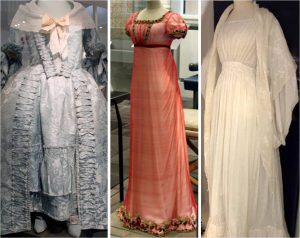 Women’s gowns changed significantly throughout the Romantic Age. Until about 1780, France had been the ‘Kingdom of fashion’. Everybody had copied French designs and styles. With the French Revolution and the rise of Napoleon to power, three things happened:
Women’s gowns changed significantly throughout the Romantic Age. Until about 1780, France had been the ‘Kingdom of fashion’. Everybody had copied French designs and styles. With the French Revolution and the rise of Napoleon to power, three things happened:
I have compiled a selection of photos of beautiful women’s gowns of 1740 – 1825. Follow me to the world of ladies’ fashion. Continue reading
Let’s leave the Romantic Age for one glamorous evening and go to the mid 18th century. We shall discover one of the major society events of the year 1756: The opening of Norfolk House in London.
Follow me to ‘All Things Georgian’, the brilliant website of Sarah Murden and Joanne Major, history detectives and acclaimed authoresses. Sarah and Joanne kindly feature my guest post about a grand event and 6 tips to succeed there as time travelling guests of the Duke and Duchess of Norfolk.
Please click here to go to the post and find out more.
Best regards,
Anna M. Thane
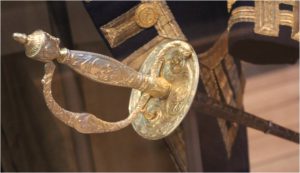 Court suits, breeches and waistcoats of the 18th century are highly aesthetic. They are, however, incomplete without the matching accessories. Therefore, stockings, dress swords, watches, buttons, etc. are in the spotlight of today’s post. I have compiled a selection of photos of these beautiful fashion items, so follow me to the world of accessories for gentlemen. Continue reading
Court suits, breeches and waistcoats of the 18th century are highly aesthetic. They are, however, incomplete without the matching accessories. Therefore, stockings, dress swords, watches, buttons, etc. are in the spotlight of today’s post. I have compiled a selection of photos of these beautiful fashion items, so follow me to the world of accessories for gentlemen. Continue reading
A gentleman wasn’t properly dressed without a waistcoat. A waistcoat was a highly elaborate piece of clothing and allowed to show off exquisite taste in fashion. The garment itself was the subject of fashion trends. You would of course suppose that its decoration varied throughout the 18th century. But did you know that the cut changed significantly, too? Learn about the styles of waistcoats throughout the decades in this post. Continue reading